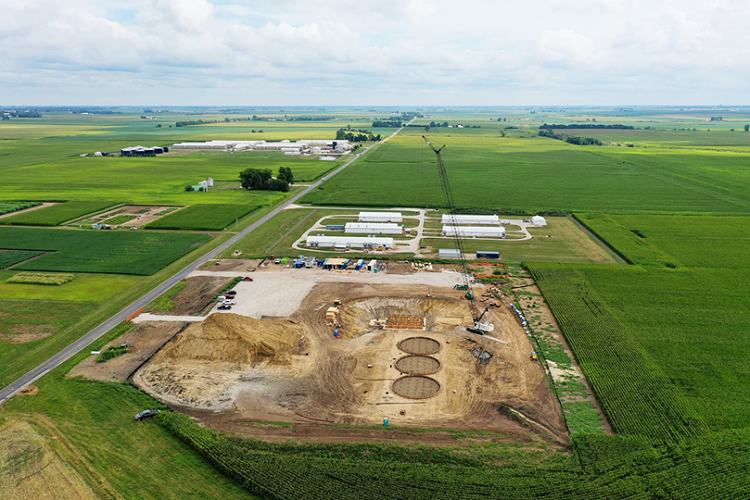University of Illinois feed mill project sees ADM, AGCO support

Site work for the new feed mill started in early June and the project is slated to be completed in autumn of 2020, said Rodney Johnson, head of the department of animal sciences, University of Illinois.
When completed, the facility is set to replace the university’s current feed production facility, which is roughly 90-years-old, he told FeedNavigator. The university has been discussing replacing the facility for about 20 years.
“It’s still producing diets for the animals we have on south farms and also creating most of the experimental diets,” he said of the university’s current facility. “That feed mill was actually where all of the critical research was done that led to the creation of the corn-soy diet, and that obviously changed the landscape of agriculture in the state of Illinois, and all over really. The place is historic and has been tremendous, but it’s time for a new facility and with state-of-the-art technology.”
The new facility is not intended to be a commercial-scale facility but will have the ability to generate small batches of feeds for use in animal nutrition research and larger batches to feed the animals raised on university farms, he said.
“There is a lot of research that’s going to need to take place to make sure that we are able to produce animal protein in an efficient manner,” Johnson said. “This new tech that will be included in this is going to allow us to get into some precision diet formulation, where maybe we can measure the nutrient composition of specific ingredients and adjust the diet formulation on the fly, for example.”
When the new mill is operational the former facility will cease production and officials with the university will decide what to do with the location, he said.
“To be in my position and to have a hand in helping facilitate this project – it’s really fantastic,” he added.
Funding the feed center
In addition to work on the site, efforts to find support and partners for the project also are ongoing, said Johnson.
The new facility is slated to cost about $20m, with about $6m in funding coming from the institution and the rest from a public-private partnership.
“There’s about $14m in debt, and it’s sort of like when you buy a house you have a moorage and an annual payment, and we’ll have the same until we retire the debt,” he said.
The goal is to raise funds to pay off the facility debt as soon as possible, he added.
The effort saw a boost at the end of August with the announcement of a $2.5m donation from Archer Daniels Midland Company (ADM), he said. Adding, “We’ve been talking to ADM for 20 years … and they’ve been at the table every opportunity they’ve had, and for them to come through like this is fantastic.”
ADM has a history of working with the animal science department at the University of Illinois, said Ryan Lane, president, ADM Animal Nutrition, North America.
“Without feed manufacturing capabilities, the department would be at risk maintaining staff and students,” he told us about why the company was interested in supporting the project. “Our commitment to the College of ACES will help them provide the needed capabilities in feed manufacturing for research, student development, and future collaborations with ADM.”
“Our intent with this contribution is to support the College of ACES and help entice a pool of talent for the next generation of leaders in the ag industry,” he said.
It has been observed that students have a declining interest in agriculture-related fields, and particularly animal science, he added.
However, there also are new feed additives and ingredients coming in the market and the University of Illinois provides a partner for the industry to explore the use of novel ingredients in production and to “provide insights on digestive health, such as targeted gut microbiota modulation,” said Lane.
The project also has seen equipment donations from Alltech and AGCO Corporation, said Johnson. AGCO donated three GSI 42’-15 ring bins and the related accessories including floors, fans, power sweeps, fans, sidewall stairs and peak walkaround.
The donation adds storage capacity for about 200,000 bushels to the upcoming feed mill, according to university information.
“Illinois Farm Bureau has also partnered with us [and] I think that’s a huge thing as well,” said Johnson. “They’re kind of the face of agriculture in the state of Illinois and to have them valuing the relationship enough to contribute to this project is very significant and meaningful.”
Building the facility
“We are right on schedule,” said Johnson about work on the site.
The floors for the grain bins have been put in place along with the floor for the feed mill, he said. “They are currently building the slip forms for pouring the concrete of the feed mill itself, and they will that do that continuous pour of concrete beginning September 17.”
The concrete feed mill exterior is set to be poured in a multi-day process, he said. Adding, “They build the forms, and the forms are jacked up about 10 to 15 inches per hour, and they continuously pour concrete for 24 hours a day … it will go from 16ft under grade to 74ft high above grade.”
The grain bins are anticipated to start being sited later this month, he said. The storage space will all for all the grain raised on campus farms to be kept at the site, which was not previously possible.
“Being able to have high-quality grain throughout the year to improve the experimental diet preparation is an important part of this as well,” Johnson said.
Internal ingredient storage will be poured as part of the slip form construction, he said. Adding, “As they move up the feed mill, as they’re pouring the concrete, they’re adjusting the forms, so they will actually kind of create a honeycomb structure of smaller concrete ingredient tanks that will then feed to the other aspects of the feed mill.”












